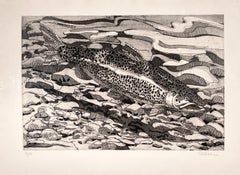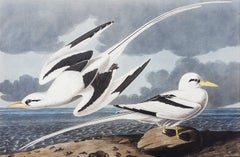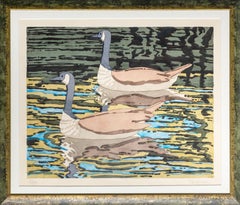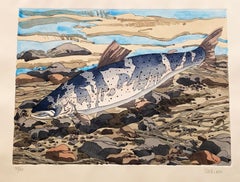Neil Welliver Animal Prints
American, 1929-2005
Landscape painter Neil Welliver was born in 1929 in Millville, Pennsylvania. He attended the Philadelphia College of Art, and then went on to receive his MFA from Yale University. There, Welliver studied with abstract artist Josef Albers who had a significant influence on his work. He began his teaching career first at the Cooper Union, and then at his alma mater, Yale, from 1956-1966. He also became the chairman of the University of Pennsylvania Graduate School Of Fine Art. Welliver’s style evolved from color field painting to more realistic depictions of New England landscapes, most notably in Maine. He settled there in 1970 but commuted to UPENN for his classes from 1966-1989.
His life was marked by frequent tragedies. In 1975, a fire consumed his entire home, studio, and all of his art. Over the next few years, his second wife, daughter, and two sons all died. He is survived by his other three sons.
His work is in several museum collections, including the Metropolitan Museum of Art; the Museum of Fine Arts, Boston; the Art Institute of Chicago; the Philadelphia Museum of Art; and the Whitney Museum of American Art.
Welliver passed away in 2005 in Belfast, Maine.to
1
Overall Width
to
Overall Height
to
3
194
161
119
94
1
1
1
1
1
1
1
1
1
1
Artist: Neil Welliver
BROWN TROUT
By Neil Welliver
Located in Portland, ME
Welliver, Neil. BROWN TROUT. Etching and aquatint, 1978. Edition of 50. Signed and numbered 16/50, and signed in pencil. 26 1/2 x 36 13/16 inches (sheet). ...
Category
1970s Neil Welliver Animal Prints
Materials
Etching, Aquatint
Related Items
Unité, Planche 3 (Set of 2) /// Surrealism Le Corbusier Etching Modern Aquatint
By Le Corbusier
Located in Saint Augustine, FL
Artist: Le Corbusier (Charles-Édouard Jeanneret) (Swiss-French, 1887-1965)
Title: "Unité, Planche 3" (Set of 2)
Portfolio: Unité
*Signed by Le Corbusier in pencil lower right. It is ...
Category
1960s Surrealist Neil Welliver Animal Prints
Materials
Etching, Aquatint, Intaglio
$14,000
H 17.75 in W 22.25 in
Tropic Bird /// Ornithology John James Audubon Florida Keys Ocean Beach Seascape
By John James Audubon
Located in Saint Augustine, FL
Artist: John James Audubon (American, 1785-1851)
Title: "Tropic Bird" (Plate CCLXII - 262; part No. 53)
Portfolio: The Birds of America, Havell Edition
Year: 1835
Medium: Original Ha...
Category
1830s Victorian Neil Welliver Animal Prints
Materials
Watercolor, Engraving, Aquatint, Intaglio
Hunting the Camelopard (Giraffe), antique African hunting engraving print, 1813
By Samuel Howitt
Located in Melbourne, Victoria
Colour aquatint after Samuel Howitt (1756/7-1822).
From Samuel Howitt's 'Foreign Field Sports' Samuel Howitt was an English painter, illustrator and etch...
Category
Early 19th Century Naturalistic Neil Welliver Animal Prints
Materials
Aquatint
Eared Grebe /// John James Audubon Ornithology Havell Edition Bird Animal Art
By John James Audubon
Located in Saint Augustine, FL
Artist: John James Audubon (American, 1785-1851)
Title: "Eared Grebe" (Plate CCCCIV - 404; part No. 81)
Portfolio: The Birds of America, Havell Edition
Year: 1838
Medium: Original Ha...
Category
1830s Victorian Neil Welliver Animal Prints
Materials
Watercolor, Engraving, Aquatint, Intaglio
$5,500
H 33.25 in W 40.25 in
African Rhinoceros Hunting, antique African hunting engraving print, 1813
By Samuel Howitt
Located in Melbourne, Victoria
Colour aquatint after Samuel Howitt (1756/7-1822).
From Samuel Howitt's 'Foreign Field Sports' Samuel Howitt was an English painter, illustrator and etch...
Category
Early 19th Century Naturalistic Neil Welliver Animal Prints
Materials
Aquatint
$165
H 7.09 in W 9.06 in
Hunting a Zebra, African hunting engraving print, 1813
By Samuel Howitt
Located in Melbourne, Victoria
Colour aquatint after Samuel Howitt (1756/7-1822).
From Samuel Howitt's 'Foreign Field Sports' Samuel Howitt was an English painter, illustrator and etch...
Category
Early 19th Century Naturalistic Neil Welliver Animal Prints
Materials
Aquatint
Salvador Dali - Le Cerf from Le Bestiaire de la Fontaine - Signed Engraving
By Salvador Dalí
Located in Collonge Bellerive, Geneve, CH
SALVADOR DALI
Le Cerf se voyant dans l'eau from Le Bestiaire de la Fontaine
1974
Hand signed by Dali
Edition: /250
The dimensions of the image are 22.8 x 15.7 inches on 31 x 23.2 in...
Category
1970s Surrealist Neil Welliver Animal Prints
Materials
Drypoint, Aquatint
$2,958
H 29.93 in W 22.84 in D 0.04 in
Unité, Planche 19 (Set of 2) /// Surrealism Modern Art Le Corbusier Bull Cow
By Le Corbusier
Located in Saint Augustine, FL
Artist: Le Corbusier (Charles-Édouard Jeanneret) (Swiss-French, 1887-1965)
Title: "Unité, Planche 19" (Set of 2)
Portfolio: Unité
*Signed in pencil lower right. It is also monogram s...
Category
1960s Surrealist Neil Welliver Animal Prints
Materials
Etching, Aquatint, Intaglio
$14,000
H 22.25 in W 17.75 in
Venados (Deer), circa 1975-1985, (A/P)
By Francisco Toledo
Located in San Francisco, CA
Francisco Toledo
Venados (Deer), circa 1975-1985
Color etching and aquatint
Plate: 8 13/16 x 11 11/16 inches
Sheet: 15 x 20 7/16 inches
Edition A/P (Artist Proof)
This limited editi...
Category
Late 20th Century Contemporary Neil Welliver Animal Prints
Materials
Etching, Aquatint
Salvador Dali - The Oak and the Reed - Signed Engraving
By Salvador Dalí
Located in Collonge Bellerive, Geneve, CH
SALVADOR DALI
The Oak and the Reed (La chêne et le roseau) from Le Bestiaire de la Fontaine
1974
Hand signed by Dali
Edition: /250
Conditions: A small tear defect has been restaured...
Category
1970s Surrealist Neil Welliver Animal Prints
Materials
Drypoint, Aquatint
$2,130
H 29.93 in W 22.84 in D 0.04 in
Catching the Badger, aquatint engraving field sport print, 1813
By Samuel Howitt
Located in Melbourne, Victoria
'Catching the Badger'
Colour aquatint by Mathew Dubourg (1786-1838) after Franz Joseph Manskirch (1768-1830).
From Samuel Howitt's 'Foreign Field Sports...
Category
Early 19th Century Naturalistic Neil Welliver Animal Prints
Materials
Aquatint
$140
H 7.09 in W 9.06 in
Torch Light Fishing in N America, aquatint engraving hunting print, 1813
By Samuel Howitt
Located in Melbourne, Victoria
'Torch Light Fishing in N America'
Colour aquatint by Merke after John Heavenside Clark (c1770-1863).
From Samuel Howitt's 'Foreign Field Sports'. Samuel...
Category
Early 19th Century Naturalistic Neil Welliver Animal Prints
Materials
Aquatint
$140
H 7.09 in W 9.06 in
Previously Available Items
Canada Geese
By Neil Welliver
Located in Long Island City, NY
Canada Geese
Neil Welliver, American (1929–2005)
Date: 1978
Soft ground etching printed on Arches Cover paper hand-colored with watercolor, signed and num...
Category
1970s American Impressionist Neil Welliver Animal Prints
Materials
Etching
SALMON
By Neil Welliver
Located in Portland, ME
Welliver, Neil. SALMON. Handcolored etching, 1977. Edition of 40, printed on cream colored Arches paper. Signed and numbered 37/40 in pencil. Published by Brooke Alexander, NY. 21 3/...
Category
1970s Neil Welliver Animal Prints
Materials
Etching
TROUT AND REFLECTIONS
By Neil Welliver
Located in Portland, ME
Welliver, Neil. TROUT AND REFLECTIONS. Etching with hand-coloring,
1980. Edition of 60, published by the artist, printed by the
University of Pennsylvania Press, Philadelphia (Welli...
Category
1980s Neil Welliver Animal Prints
Materials
Etching
Canada Geese
By Neil Welliver
Located in Fairlawn, OH
Signed and numbered in pencil
Edition: 75
Published by Brooke Alexander, New York
Reference: Welliver 50-1
Category
1970s Neil Welliver Animal Prints
Materials
Lithograph
Neil Welliver animal prints for sale on 1stDibs.
Find a wide variety of authentic Neil Welliver animal prints available for sale on 1stDibs. You can also browse by medium to find art by Neil Welliver in etching, aquatint, woodcut print and more. Not every interior allows for large Neil Welliver animal prints, so small editions measuring 30 inches across are available. Customers who are interested in this artist might also find the work of Currier & Ives, Louis Prang, and Lionel Edwards. Neil Welliver animal prints prices can differ depending upon medium, time period and other attributes. On 1stDibs, the price for these items starts at $4,000 and tops out at $4,800, while the average work can sell for $4,100.




